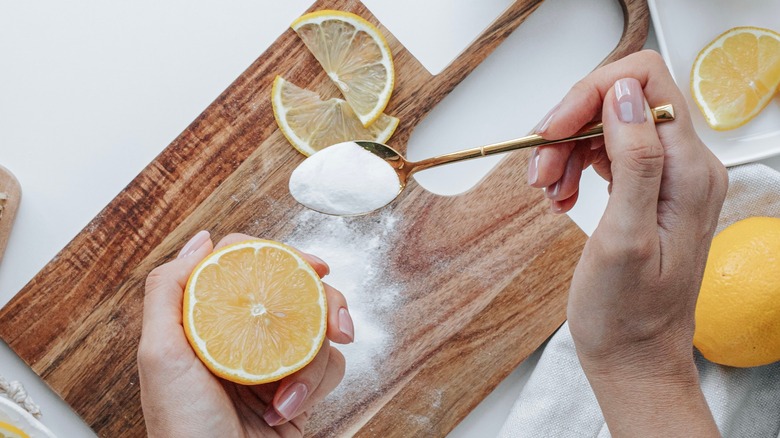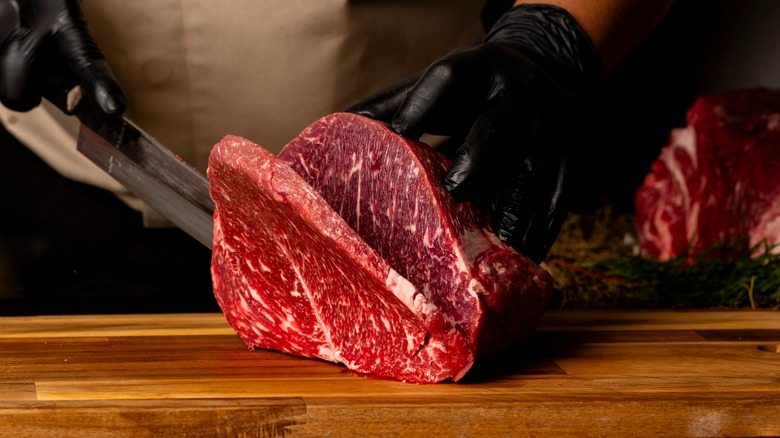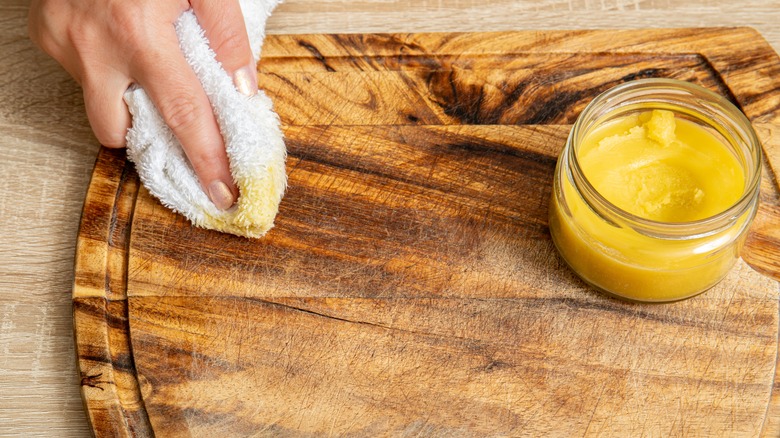You Might Be Cleaning Your Wooden Cutting Board Wrong
Let's get this out of the way first: There are two wrong ways to clean a wooden cutting board. One is to put it in the dishwasher. The other is to leave it to soak in the kitchen sink. Both are wrong for the same reason: Excess exposure to water could warp or crack your board, which is otherwise a wonderful, resilient tool to have in the kitchen. Compared to other materials like plastic, wooden boards keep knives sharper longer. They certainly look nicer, and don't create microplastic waste when you use them. And there's even some evidence that wood is less hospitable to bacteria than plastic — in other words, better at preventing food-borne illness.
More good news: Aside from making sure it doesn't spend too much time in the water, you can clean a wooden cutting board pretty much like you'd clean anything else — in the kitchen sink, with warm soapy water and a regular old kitchen sponge (use a plastic scraper or metal spatula to remove any stubborn bits sticking to it). Clean it on both sides, even if you've used just one. Then wipe off the moisture with a towel and let the board air-dry completely before storing it.
Still, there are a few best practices to keep in mind for the safe, long-term use of a wooden cutting board. You'll want to sanitize it from time to time, as well as oil it to keep it well-seasoned. Here's what you need to know.
What to know about owning a wooden cutting board
In general, wooden cutting boards are friendlier to knives than plastic, glass, or ceramic — they're softer, so they damage blades less over time. If you're looking for the boards that are best for knives, seek out an end-grain cutting board or butcher block, made from assembling the ends of cut pieces of wood; because the surface is already a little roughed up, it's better able to absorb knife cuts. If you're looking for a wood board that provides the best protection against bacteria, though, go with bamboo, which is harder and less porous than other types of wood.
That said, to avoid cross-contamination, it's always a good idea to keep a few different cutting boards around for different purposes — and to have one devoted specifically to raw meat that you wouldn't use for cutting, for instance, fruits and veggies that you're planning on serving uncooked. And simply on the level of taste, you may want to keep a separate cutting board that has never been touched by the likes of an onion or a clove of garlic. That way, if you're cutting up an apple — or some chocolate — it doesn't end up inadvertently tasting like an allium. If that apple does taste like onion, though? That's a weird-tasting reminder that it's time to deodorize the board.
Tips for keeping your wooden cutting board in great shape
Except for regular scrubbings, there are a few other things you can do to keep your wooden cutting board in great shape. If it picks up any food scents, deodorizing is a cinch: Get a lemon and a handful of salt. Sprinkle salt over the board, then cut the lemon in half and use the cut halves to rub the salt into the grain (distilled white vinegar also works). Rinse and repeat as needed if you detect any lingering scents.
If you've used the board to cut raw meat and want to take the extra step of sanitizing it, the USDA recommends mixing a tablespoon of chlorine bleach into a gallon of water. After cleaning the board like usual, pour the bleach mixture all over its surface. Let that sit for a few minutes, then rinse it off and let it air-dry.
Every month or so, you'll want to season your cutting board to protect against water and/or staining (seasoning: it's not just for cast iron!). It's a simple process that just requires taking a bit of food-grade mineral oil and using a paper towel to rub it all over the clean board, then stand it upright and let it air-dry overnight. The next day, use a towel to wipe off any excess oil; then, if you want to add another level of protection, wax the surface with food-grade beeswax.


